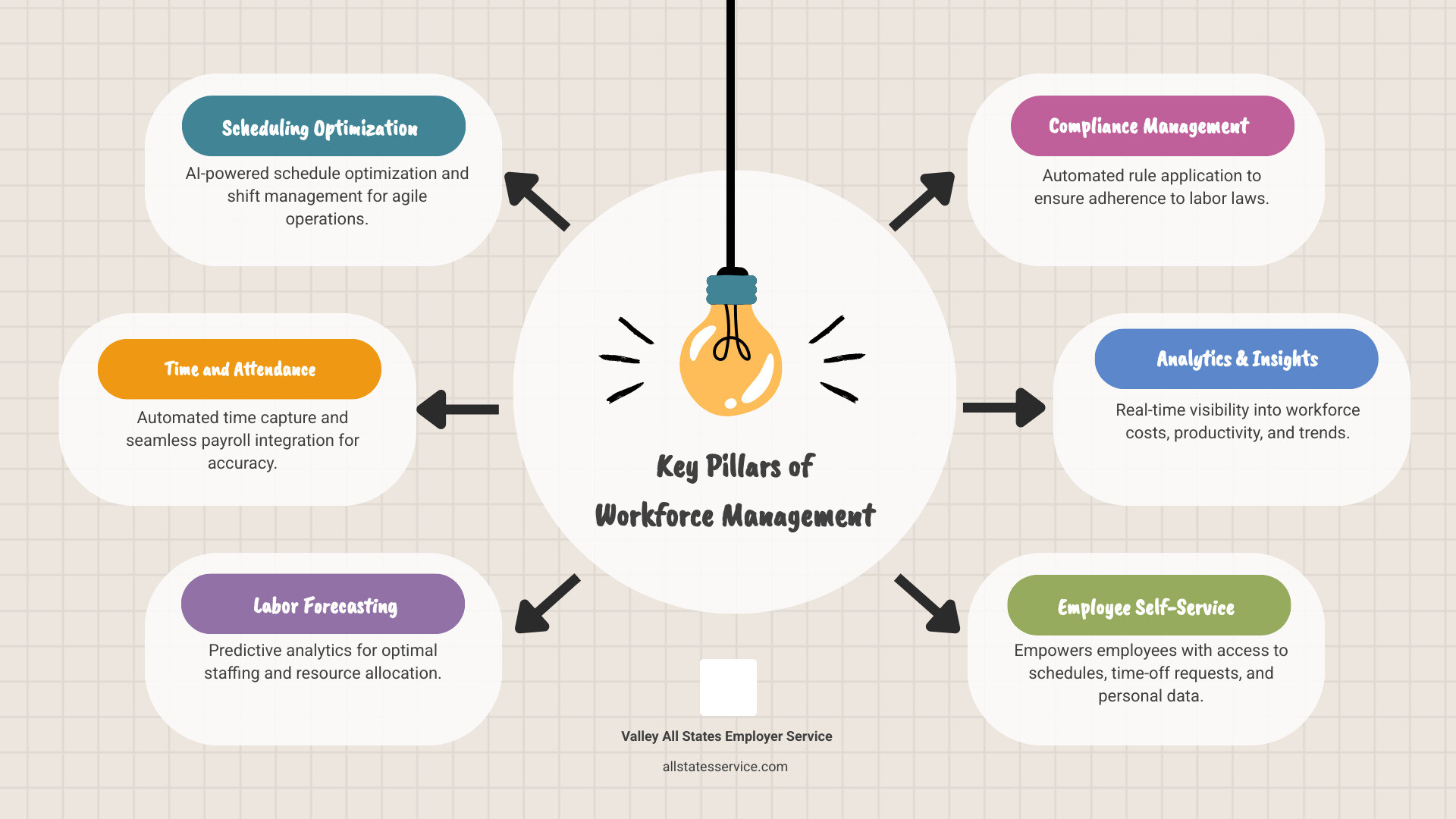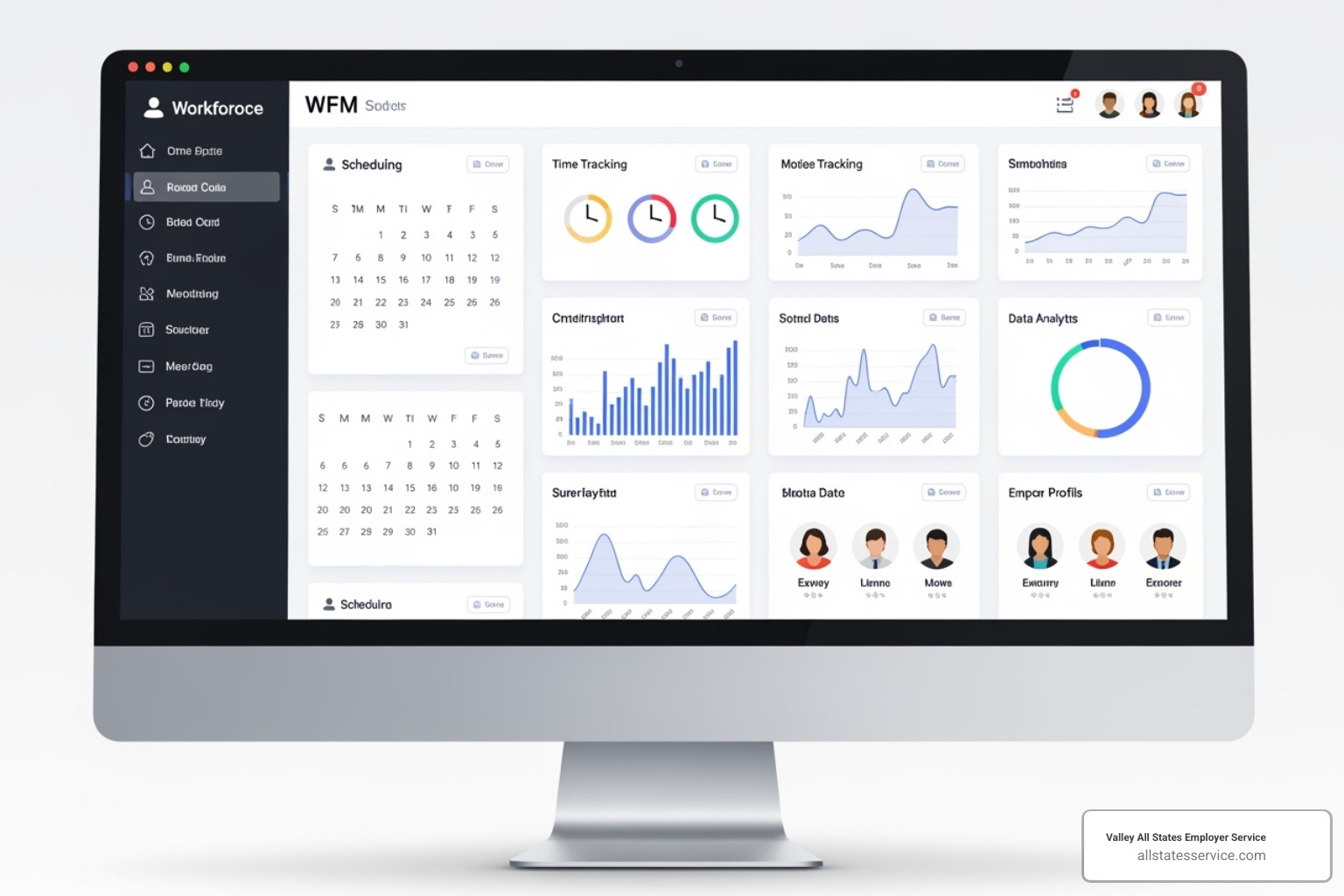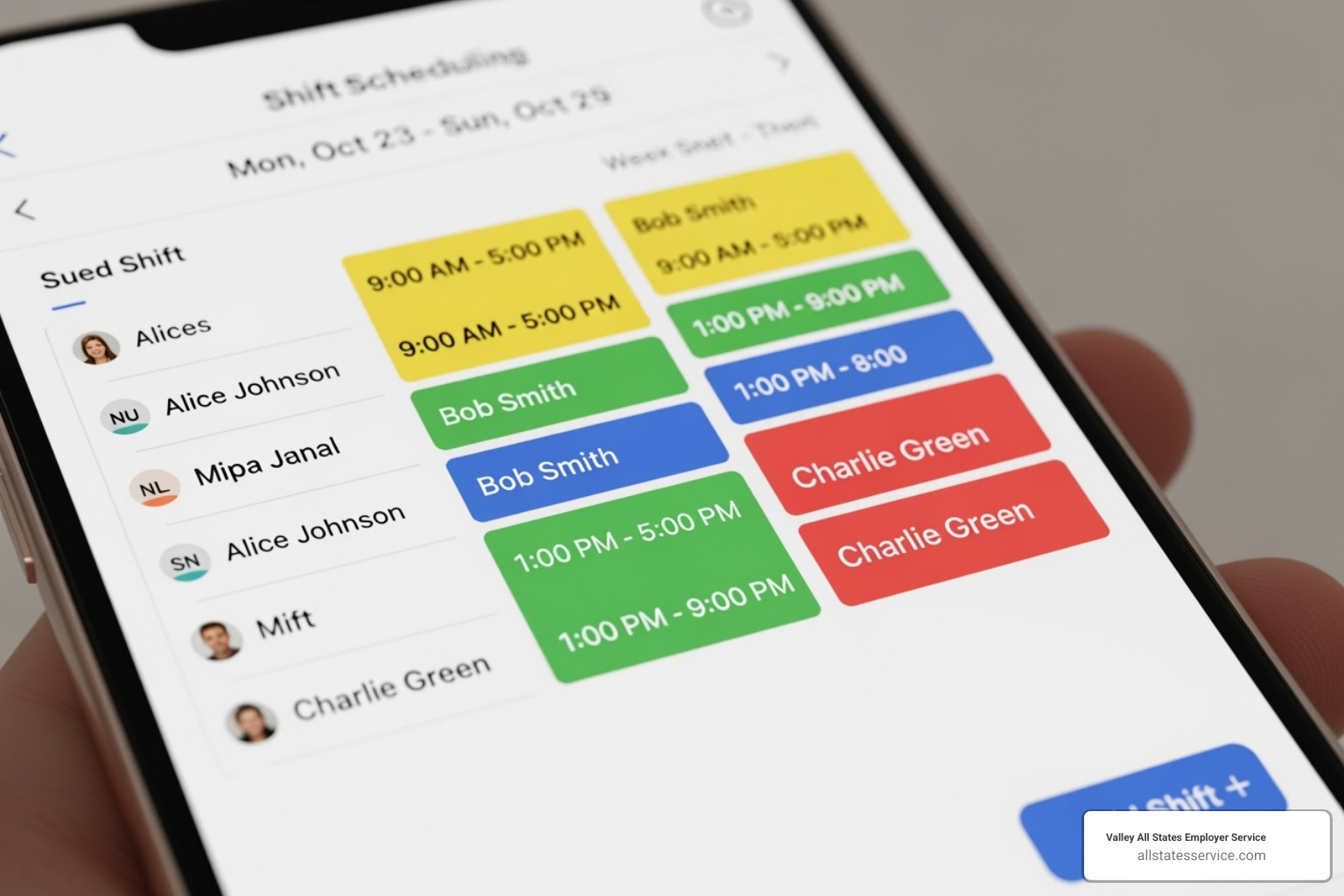Workforce management solutions: Your Perfect 2025
What is Workforce Management and Why Does It Matter?
Workforce management solutions help organizations manage their workers, providing the operational agility needed to thrive. At its core, workforce management is about deploying your hourly workers effectively while maintaining compliance and controlling costs.
Key components include:
- Time and Attendance Tracking: Automated time capture and payroll integration.
- Employee Scheduling: AI-powered schedule optimization and shift management.
- Labor Forecasting: Predictive analytics for staffing needs.
- Compliance Management: Automated rule application for labor laws.
- Analytics and Insights: Real-time visibility into workforce costs and trends.
The numbers tell a compelling story. Companies using modern WFM solutions report an 80% gain in scheduling efficiency, an 11% decrease in labor costs, and a 5.2% increase in revenue per labor hour. Managers also save over 5 hours per week on administrative tasks.
This isn’t just about saving time or cutting costs. As one HR professional noted, “moving everything to mobile was a game changer” for employee engagement. When your workforce feels empowered and connected, productivity follows.
The workplace has fundamentally changed. Paper timesheets and manual scheduling create chaos, leading to buddy-punching, scheduling conflicts, and compliance headaches. Modern businesses need solutions that can handle complex pay rules, manage dynamic workforces, and keep pace with ever-changing labor regulations.
Effective workforce management solutions are no longer a luxury but a necessity. With a diverse mix of hourly, salaried, and remote workers, complexity demands a sophisticated approach. For businesses specializing in employment compliance, robust WFM is crucial for navigating labor laws, from tracking overtime to ensuring proper breaks. Without these systems, businesses risk significant penalties and operational disruptions.

The Core Engine: Key Components and Functionalities of WFM Software
Think of workforce management solutions as the engine powering your operation. WFM software combines several key components into one system, giving you complete visibility into your workforce data.

Essential Features of Modern Workforce Management Solutions
When shopping for a WFM system, focus on the features that drive results.
Time and attendance tracking is the backbone of any solid system. Modern systems use mobile or biometric scanners to eliminate buddy punching. One company cut its payroll processing time dramatically just by switching to fingerprint recognition.
Employee scheduling uses smart tools to create optimal schedules based on demand forecasts and employee availability. Your team can swap shifts through an app, and you can post open shifts for bidding. Companies using these tools report spending 75% less time on scheduling each month.
Absence management is simplified with a portal for time-off requests. You can approve or deny based on policies and staffing needs, eliminating sticky notes and forgotten requests.
Labor forecasting turns historical data into a crystal ball for future staffing. The system analyzes patterns to predict how many people you’ll need and when, preventing overstaffing or understaffing.
Task management capabilities help you assign specific work to team members and track progress, which is valuable for hourly workers with multiple responsibilities.
The analytics and insights component transforms data into clear, actionable insights. Some companies have saved over $1.6 million annually by gaining better visibility into workforce costs and trends.
For smaller businesses, we can help steer these decisions. You might also check our guide on HR Compliance for Small Business to cover all your bases.
How Core Components Boost Productivity
When these components work together, they create significant productivity gains.
Automated workflows eliminate tedious manual work. Imagine cutting HR administrative tasks by 75% or finishing payroll a full day earlier.
Data-driven decisions become second nature with real-time insights. You get clear, actionable data to make smart choices about staffing and budgeting.
Reduced administrative tasks free up your managers to lead people instead of pushing paper. Many managers save over 5 hours per week by not having to fix timesheet errors or manually create schedules.
Manager time savings occur because everything lives in one place. A single dashboard simplifies their daily routine.
Employee self-service is a win-win. Your team can manage their schedules and access information like W-2s without bothering HR, freeing your HR team for more strategic work.
Five must-have features for hourly teams are: mobile-first scheduling and time tracking, automated compliance checks, real-time communication, integrated payroll, and labor cost analytics.
The Evolution of WFM: From Spreadsheets to Smart Solutions
Remember the chaos of managing schedules with sticky notes and Excel spreadsheets? Those days of frantically calling employees to cover shifts and manually calculating overtime are becoming a distant memory. The change of workforce management solutions from basic tracking tools to intelligent platforms is one of the most significant shifts in how businesses operate.
This evolution is about more than upgrading software; it’s about fundamentally changing how we connect with and empower our teams. What started as simple time clocks has grown into comprehensive systems that predict needs and put control directly into employees’ hands.

The Impact of AI and Mobile Accessibility
The game changed when artificial intelligence met mobile technology. Today’s workforce management solutions don’t just track what happened yesterday; they predict what you’ll need tomorrow.
AI-powered forecasting has become incredibly sophisticated, analyzing everything from seasonal trends to local events and weather to predict staffing needs. This accuracy helps businesses avoid the costly mistakes of over or understaffing.
Machine learning takes this further by learning from your specific business patterns, identifying trends that even experienced managers might miss.
Perhaps the biggest breakthrough has been mobile-first design. With millions of workers managing schedules from their smartphones, accessibility is everything. Your team can check shifts, clock in, or request time off from anywhere.
This shift toward employee empowerment has been transformative. Workers can set availability, volunteer for open shifts, and coordinate swaps with colleagues without involving management, creating a new level of autonomy.
Real-time communication through mobile apps eliminates miscommunications. When schedules change, everyone knows instantly. Leading platforms like Microsoft Teams can even connect to your WFM system, creating a unified hub for communication and scheduling.
How Technology Improves the Employee Experience
Modern workforce management solutions have turned sources of frustration into opportunities for flexibility and growth.
Flexible scheduling is now the norm. Smart systems balance business needs with employee preferences, creating schedules that work for everyone. Happy, engaged workers are more productive and stay longer.
Shift swapping through mobile apps has eliminated countless headaches. Workers can coordinate directly, and the system ensures all labor laws and company policies are followed.
Instant notifications keep everyone in the loop about schedule changes, new shifts, or important announcements.
Access to information is a huge win for employees. They can pull up pay stubs, review accrued time off, or check policies without tracking down HR. This self-service approach saves time for everyone and leads to an improved work-life balance.
For businesses looking to improve their employee experience, partnering with Employee Benefits Outsourcing Companies can provide additional support.
Open uping Value Across Your Organization: The Benefits of Effective Workforce Management Solutions
When you implement robust workforce management solutions, the benefits ripple outward, changing how every corner of your organization operates. From the finance team celebrating reduced payroll errors to IT breathing easier with streamlined systems, everyone wins.

Benefits for HR and Operations
Your HR and Operations teams can transform their daily grind into a strategic advantage.
Reduced turnover is a major win. When employees have predictable schedules and fair compensation, they stick around. Deputy customers have seen a 46% reduction in employee turnover, which means fewer recruiting costs and more experienced team members.
Improved scheduling efficiency is revolutionary. Modern systems eliminate the chaos of filling shifts and resolving conflicts. Workforce.com customers report an 80% gain in scheduling efficiency, while Deputy users spend 75% less time on monthly scheduling.
Streamlined onboarding helps new hires feel welcome from day one. An integrated WFM system allows new employees to complete paperwork, access training, and see their schedules before their first shift. For guidance, explore our resources on Employee Onboarding Compliance.
This all leads to increased productivity. Deputy customers report a 30% increase in overall productivity when schedules work and communication flows.
Benefits for Finance and IT
Your Finance and IT departments also experience dramatic improvements.
Optimized labor spend gives your Finance team crucial visibility. With real-time insights into actual hours versus budget, you can make strategic financial decisions. Workforce.com customers see an 11% decrease in labor costs and a 5.2% increase in revenue per labor hour.
Reduced payroll errors is a favorite benefit. When your WFM system feeds clean data directly into payroll, mistakes disappear. Deputy customers report a 50% reduction in payroll processing time, ensuring everyone is paid correctly and on time.
Improved data security gives IT peace of mind. Centralizing sensitive employee information in one secure system reduces breach risks and simplifies compliance reporting.
System integration makes IT’s life easier. Modern WFM solutions work with your existing HRIS, ERP, and payroll systems, eliminating data silos and creating a single source of truth.
Consider how a Web-Based Payroll Service can integrate with your WFM strategy for an even smoother operation.
The Buyer’s Playbook: How to Choose and Implement the Right WFM Solution
Finding the right workforce management solutions doesn’t have to be overwhelming. The key is understanding your specific needs and finding a solution that grows with your business.
A Step-by-Step Guide to Selecting Your Perfect WFM Fit
Follow these steps to avoid common pitfalls.
First, assess your current situation. What are your biggest pain points? Is it the weekly scheduling headache, or are compliance worries keeping you up at night? Write down your frustrations to create a roadmap for the right solution.
Next, define what success looks like. Instead of vague goals, aim for specifics like “cut scheduling time in half” or “reduce overtime costs by 20%.” Clear goals help you measure a system’s effectiveness and keep vendors honest.
Then, shop around. The WFM market is packed with options, so look for vendors with solid reputations in your industry. Check customer reviews on sites like G2 and Capterra, paying close attention to feedback on customer service.
Request a customized demo. Don’t settle for a generic presentation. Ask vendors to show you exactly how their system handles your unique pay rules, complex scheduling needs, or specific state compliance requirements.
Your industry matters. A system built for restaurants might not work for healthcare. Look for solutions that understand your world.
To dive deeper, Download the Forrester WFM Report for expert insights that could save you from costly mistakes.
Overcoming Common Implementation Challenges
Even the best software can fail with poor implementation. Fortunately, most problems are preventable.
Data migration is often the first hurdle. Moving years of records is daunting. Plan early by cleaning up your existing data. Consider moving data in phases to minimize risk and catch problems before they escalate.
Your team might resist change. People get comfortable with familiar systems. Show them what’s in it for them, like checking schedules on their phone or easily swapping shifts. Focus on benefits, not features, and provide plenty of hands-on training.
Getting leadership on board is crucial. If department heads aren’t committed, the project will struggle. Share success stories and data on time and money saved to make it clear this is a strategic business investment.
Consider a phased rollout. Start with one department or module to learn what works and fix problems while they’re small. This thoughtful approach avoids the chaos of a failed big-bang launch.
Throughout this process, our Compliance Management System can provide the foundation you need for a successful WFM implementation.
Staying Ahead of the Curve: Compliance and Future WFM Trends
The world of labor law never stands still, and neither should your approach to compliance. Modern workforce management solutions serve as your vigilant guardians in this ever-changing landscape, while preparing your business for tomorrow’s innovations.
How Workforce Management Solutions Ensure Labor Law Compliance
Today’s workforce management solutions transform the complex challenge of compliance into an automated advantage.
Automated Rule Application forms the backbone of modern compliance. Your WFM system can be configured to automatically apply intricate labor laws, whether that’s California’s break requirements, federal overtime rules, or minimum wage updates.
Break and Overtime Tracking becomes effortless as the system precisely monitors employee breaks and automatically calculates overtime based on your predefined rules. This eliminates human error and ensures accurate compensation.
For businesses in jurisdictions with Fair Workweek Laws, WFM solutions provide the tools to manage predictive scheduling requirements, handling advance notice and compensation for last-minute changes seamlessly.
Accurate Record-Keeping is your shield during audits. WFM systems maintain meticulous digital records of all time, attendance, and scheduling data, providing an indisputable paper trail.
Compliance starts from the moment you hire. Our expertise in workforce eligibility verification complements your WFM efforts. Learn how E-Verify and I-9 processes and best practices for I-9 Record Keeping create a bulletproof compliance foundation.
The Future of Workforce Management
The WFM landscape is evolving at breakneck speed. Here’s where we’re headed.
Hyper-personalization is the next frontier. Future systems will adapt to individual preferences for shifts, communication styles, and career paths, creating a more custom employee experience.
Gig Economy Integration is no longer optional. Tomorrow’s WFM solutions will seamlessly manage traditional employees alongside freelancers and contractors, handling different pay structures and compliance within one platform.
Advanced Predictive Analytics will revolutionize workforce planning. AI will predict employee attrition, identify performance trends, and spot skill gaps months in advance, changing reactive HR into strategic planning.
Wellness and Engagement Tools are becoming standard. Future platforms will incorporate well-being monitoring, continuous feedback, and culture-building tools, recognizing that a healthy workforce is a productive one.
Sustainability in Scheduling reflects growing corporate responsibility. WFM solutions are beginning to optimize schedules to reduce energy use and minimize commute times. It’s workforce management with a conscience.
Conclusion: Building a Foundation for Success
The change from spreadsheet chaos to strategic workforce control isn’t just possible – it’s happening right now in businesses across the country. Workforce management solutions have evolved far beyond simple time clocks into powerful platforms that reshape how organizations connect with their people.
Think about what we’ve covered: the strategic advantage of having real-time visibility into your labor costs, the employee empowerment that comes from mobile scheduling and self-service tools, and the business growth that naturally follows when your workforce feels engaged and valued. These aren’t just nice-to-have features anymore. They’re the building blocks of modern business success.
But here’s something that often gets overlooked in all the talk about scheduling efficiency and cost savings: foundational compliance. You can have the most sophisticated workforce management system in the world, but if your basic employment verification isn’t rock-solid, you’re building on shaky ground.
That’s where the real magic happens. When your workforce management strategy includes bulletproof compliance from day one, everything else falls into place. Your scheduling becomes more confident because you know every employee is properly verified. Your payroll runs smoother because your records are pristine. Your managers sleep better because they’re not worried about surprise audits.
At Valley All States Employer Service, we’ve seen how the right compliance foundation transforms workforce management from a necessary headache into a competitive advantage. Our expert, impartial, and efficient verification processes don’t just check boxes – they create the bedrock of trust that allows your entire workforce management strategy to flourish.
When you minimize errors and administrative burdens at the compliance level, you free up mental space and resources to focus on what really drives your business forward: creating an environment where your people thrive, your operations hum, and your bottom line reflects the power of getting workforce management right.
Ready to build your workforce management strategy on a foundation that won’t crack under pressure? Learn more about our E-Verify Services and find how proper verification sets the stage for everything else to work beautifully.